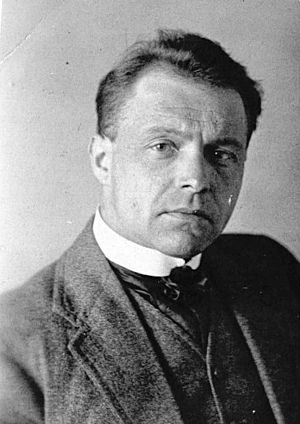Aloys Fleischmann (Senior) facts for kids
Aloys Georg Fleischmann (24 April 1880 – 3 January 1964) was a German composer, cathedral organist and choirmaster.
Life
Fleischmann was born in Dachau, Kingdom of Bavaria, German Empire. He was the only child of the Dachau shoemaker and founding member of the Dachau choir, the Liedertafel, Alois Fleischmann (1844–1914) and of Magdalena née Deger (1846–1928). From 1887–1894 he attended the Dachau primary school for boys. He was given private classes in music, music theory and Latin and in 1896 he was admitted to the preparatory two-year course at the Royal Academy of Music in Munich. Having passed the entrance examination, he studied there from 1898–1901 taking the subjects organ, conducting and, with Josef Rheinberger, composition. He graduated with first class honours in all subjects.
In January 1902 he was appointed organist and choirmaster to the parish church of St. Jakob in Dachau. There he founded a choir school and a school of music, in which children could learn music and purchase instruments at minimal cost. With the support of musician friends in Munich and members of the artists’ colony of Dachau (Hans von Hayek, Adolf Hölzel, August Pfaltz, Hermann Stockmann) he worked to revive the local tradition of Christmas children’s festivals, composing the music for a nativity play every year from 1903–1906. In 1905 he produced his Die Nacht der Wunder [The Night of Wonders] based on a text by Selma Lagerlöf, with stage design and costumes by von Hayek, Pfaltz and Stockmann. The Dachau orchestral musicians (including Adolf Hölzel) were augmented by members of the Munich court orchestra and choir. The play was highly successful, was widely reviewed, even in New York.
In 1905, Fleischmann married the Irish pianist Tilly Swertz, who had just graduated from the Royal Academy of Music in Munich. Her parents had emigrated from Dachau to Cork in 1879, where her father, Hans Conrad Swertz, became organist and choirmaster at the Catholic Cathedral of St Mary and St Anne. In 1906, Fleischmann was appointed to his father-in-law’s post in Cork; he worked there until 1961, when his health failed.
Being a subject of Kaiser Wilhelm II, Aloys Fleischmann was declared an enemy alien by the British government during the First World War and was interned on 4 January 1916, at first in Oldcastle, County Meath and from 1918 on the Isle of Man, from where he was deported to the Weimar Republic in 1919. Not until September 1920 was he permitted to return to Ireland. In the independent Irish Free State, he took on new responsibilities in addition to his work at the cathedral. From 1920–58 he taught singing and piano at the seminary of the diocese of Cork, St Finbarr's College, Farranferris; from 1922–37 he was professor of harmony and choral singing at the Cork School of Music.
As a church musician and music teacher, Fleischmann had a significant impact on a number of younger Irish composers and musicians, among them Seán Ó Riada, who was a pupil in Farranferris and who dedicated his Hölderlin Songs to his former teacher in 1964. Among the Fleischmanns' friends were Arnold Bax, Herbert Hughes, E. J. Moeran and Frederick May.
Fleischmann died in Cork, Ireland aged 83. Aloys and Tilly Fleischmann's son was the composer Aloys Fleischmann (Junior).
Compositions
Aloys Fleischmann created over 500 compositions, most of them unpublished, among which are stage works, sacred and secular vocal and instrumental music and almost 100 Lieder. His nativity play Die Nacht der Wunder [The Night of Wonders] made his name. It stands at the beginning of a tradition reaching to the Easter and nativity plays of Carl Orff. A catalogue of the Fleischmann compositions was compiled by Séamas de Barra and published in Cunningham, Fleischmann, de Barra (2010). A further catalogue was compiled by Andreas Pernpeintner and published on the library website of the University of Munich and on the Bavarian Musicians Lexikon Online.
Commemorative exhibitions
The life and work of Aloys and Tilly Fleischmann was documented in three exhibitions in 2010: In the Cork City Central Library, the Cork Public Museum and in the Bezirksmuseum Dachau (Dachau District Museum).



